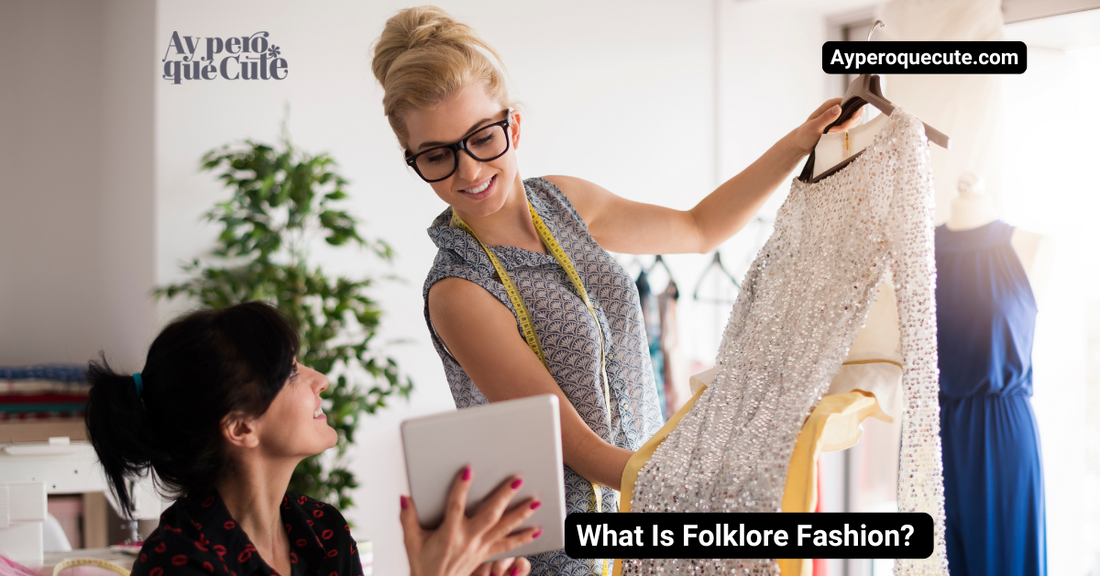
What Is Folklore Fashion? Best Guide
Share
Folklore fashion is more than just a trend, it’s a visual expression of cultural history, heritage, and individuality. With roots in traditional, rural clothing from around the world, folklore fashion celebrates handcrafted artistry, natural materials, and meaningful storytelling through design.
In today’s fashion world, folklore is making a strong comeback. As modern consumers seek authenticity, sustainability, and a deeper connection to their clothing, the timeless charm of folklore-inspired fashion continues to stand out. It's not only aesthetically rich but also grounded in cultural significance and personal expression.
In this article, you'll explore what folklore fashion truly means, where it came from, how it evolved over time, and how it continues to inspire designers and wearers today. Whether you’re curious about its history, want to distinguish it from similar styles like boho or cottagecore, or you're looking for inspiration to embrace it in your own wardrobe, this guide covers it all.
Read also: Webfreen.com Fashion: The Ultimate Guide to Affordable and Trendy Style
What does Folklore mean in Fashion?
Folklore fashion refers to clothing styles inspired by traditional, rural, and indigenous garments passed down through generations. It often reflects the customs, environment, and daily life of specific communities, blending function with deep cultural symbolism.
Unlike boho or cottagecore, which draw from broad lifestyle aesthetics or romanticized rural ideals, folklore fashion is directly tied to real cultural heritage. It carries stories—woven, embroidered, and stitched into every piece.
Core Features of Folklore Fashion:
-
Inspired by traditional and rural clothing: Often based on garments worn by communities in specific regions.
-
Includes handcrafted elements: Embroidery, weaving, and textile techniques that are often passed down through generations.
-
Tied to cultural storytelling: Symbols and patterns often represent beliefs, events, or local traditions.
A Short History of Folklore Fashion
Folklore fashion didn’t start on runways; it began in villages, among artisans, farmers, and storytellers. Here's how it evolved:
18th–19th Century: European Exoticism
-
European elites began incorporating elements of “exotic” dress into fashion, such as Turkish robes or Asian textiles, viewed as luxurious novelties.
Early 1900s: The Bohemian and Political Shift
-
Artists and political groups in cities like New York and Paris wore peasant blouses and embroidered garments as symbols of identity and rebellion.
-
Russian émigrés in Paris began handcrafting traditional designs for major fashion houses, blending heritage with haute couture.
1970s: The Hippie Movement and Counterculture
-
The rise of hippie culture brought renewed interest in handmade, folk-inspired clothing.
-
Patterns, fabrics, and silhouettes from places like India, Mexico, and Eastern Europe became part of everyday fashion.
Modern Day: Folklore on the Runway
-
Designers like Yves Saint Laurent, Dolce & Gabbana, and Zandra Rhodes reinterpreted folk styles in high fashion.
-
The look continues to resurface, with modern designers using traditional techniques in new, globally inspired ways.
Key Elements of Folklore Fashion
Natural fibers like cotton, wool, and linen
Folklore fashion heavily relies on natural fibers that are comfortable, breathable, and long-lasting. These materials reflect the self-sufficient lifestyles of traditional communities who sourced from nature and valued durability in everyday wear.
Embroidery with cultural motifs
Embroidery in folklore clothing is often done by hand and carries deep meaning. Patterns may represent spiritual beliefs, local legends, or natural elements like animals and flowers, turning each garment into a wearable piece of heritage and storytelling.
Flowing silhouettes and layering
The typical shapes in folklore fashion are loose and flowing, designed for movement, comfort, and modesty. Layering garments such as skirts, aprons, shawls, and blouses also allowed people to adapt clothing for different climates and occasions.
Earth tones and natural color palettes
Traditional folklore pieces often feature earthy colors like browns, olive greens, ochres, creams, and burgundy. These colors were historically derived from natural dyes and are closely connected to the land, seasons, and materials used in local regions.
Handmade accessories and detailing
Accessories like belts, sashes, scarves, hats, and jewelry are commonly handmade using regional techniques. These pieces are not just decorative—they add identity and meaning to the outfit, with unique details passed down through generations.
Cultural Origins and Global Influence
Folklore fashion is deeply rooted in the traditions of communities across the world. In Latin America, traditional garments like the huipil and pollera are both functional and symbolic, reflecting indigenous heritage and regional identity. In Eastern Europe, embroidered blouses and wool skirts form a vital part of national dress, often passed down as heirlooms. African folklore fashion includes vibrant prints, beadwork, and textiles like kente cloth, while Asian traditions contribute layered robes, silk garments, and ornate motifs.
As fashion globalized, designers began borrowing these elements, not always with a full understanding of their significance. Embroidered tops, layered skirts, and colorful prints became popular far beyond their regions of origin. Some of this borrowing resulted in meaningful cultural exchange, supporting artisans and preserving techniques. However, it has also led to cases of cultural appropriation, where sacred or symbolic clothing is used merely as aesthetic, stripped of its deeper value.
Understanding the origins of folklore fashion helps us appreciate it in a way that’s respectful, informed, and rooted in authenticity, not just style.
Folklore Fashion in the Latina Community
In the Latina community, folklore fashion is not just worn, it's lived. It plays a role in celebrations, heritage, identity, and daily life. Garments like the huipil (a woven blouse), the rebozo (a versatile shawl), and the pollera (a wide traditional skirt) are more than just beautiful, they're cultural statements passed down through generations.
These garments represent stories of ancestry, social values, and craftsmanship. Often handmade by women in their communities, they reflect both regional pride and personal creativity. Today, many Latinas incorporate these pieces into modern outfits, honoring their roots while embracing contemporary fashion.
Popular Regional Elements:
-
Mexican embroidery: Bold floral motifs stitched by hand onto cotton and linen.
-
Andean layering techniques: Warm, practical, and colorful textiles suited for mountainous climates.
-
Caribbean cotton lace styles: Light, breathable fabrics with intricate cutwork, often used in festive attire.
How Have Designers Modernized Folklore Fashion?
Over the years, folklore fashion has moved from small rural communities to major fashion runways. Designers across the globe have found inspiration in traditional styles and given them a fresh, modern twist.
-
Zandra Rhodes: Hand-Painted Ethnic Shapes
British designer Zandra Rhodes brought folklore to life using bold colors and hand-painted prints. She took inspiration from traditional ethnic garments and transformed them into eye-catching, artistic fashion statements. -
Yves Saint Laurent: Russian-Inspired Couture
In the 1970s, Yves Saint Laurent showcased a Russian-inspired collection that featured rich fabrics, full skirts, and embroidered jackets. His work helped bring peasant-style clothing into the world of luxury fashion. -
Dolce & Gabbana, Galliano, Anna Sui: Blending Tradition and Trend
These designers often mix folklore elements, like embroidery, flowing shapes, and heritage patterns, into their collections. Their pieces reflect how traditional styles can still feel current, fashionable, and globally relevant.
Folklore Fashion vs. Cottagecore vs. Boho
To many people, folklore, cottagecore, and boho styles might look similar at first glance. But each one has a different background, mood, and message.
|
Style |
Key Features |
Core Differences |
|
Folklore |
Cultural motifs, handcrafted detail |
Deeply rooted in ethnic traditions and storytelling |
|
Cottagecore |
Soft florals, farm life vibes |
Focuses on idealized countryside living and simplicity |
|
Boho |
Eclectic, 70s-inspired, relaxed vibe |
Emphasizes freedom, creativity, and nonconformity |
Understanding these differences helps you choose a style that aligns with your values, background, or personal taste.
How to Style Folklore Fashion Today?

Incorporating folklore fashion into your wardrobe can be easy and meaningful. The key is blending traditional pieces with modern elements respectfully and stylishly.
Here’s how to start:
-
Choose a folklore statement piece like an embroidered blouse, a folk-patterned skirt, or a handcrafted shawl to build your look around.
-
Mix with modern staples such as denim, neutral knits, or tailored pieces to create a balance between old and new.
-
Add culturally inspired accessories, such as woven bags, artisanal jewelry, or belts with traditional patterns, to enhance your outfit’s authenticity.
-
Stick to earthy, nature-inspired colors like terracotta, olive green, deep blues, and soft neutrals to stay aligned with folklore’s organic roots.
Folklore Fashion and Sustainability
One of the strongest values behind folklore fashion is its natural alignment with sustainability. Unlike fast fashion, folklore pieces are often handmade using time-honored techniques that prioritize quality over quantity. These garments are built to last, not just in durability but in cultural meaning.
Folklore fashion reflects the essence of slow fashion. It encourages mindful production, with many items crafted by local artisans who use regionally sourced, natural materials. Supporting these creators helps keep traditional crafts alive and provides fair wages and recognition for their work.
By choosing folklore-inspired clothing, wearers invest in items that have both aesthetic and ethical value. These are not throwaway trends but pieces that tell a story, hold personal significance, and support responsible consumption. In a world driven by fast-paced fashion cycles, folklore fashion offers a slower, more thoughtful approach, one that honors the planet and the people who make our clothes.
Final Thoughts: Why Folklore Fashion Matters
Folklore fashion is more than just style, it’s a powerful way to preserve and celebrate cultural identity. Each garment carries stories from the past, passed down through generations, reminding us of who we are and where we come from. Whether worn during traditions or integrated into modern wardrobes, these pieces connect us to heritage in a meaningful, visible way.
Folklore fashion is a blend of expression and respect. It allows individuals to wear their roots proudly while inviting others to appreciate the beauty of cultural diversity. In embracing folklore fashion, we don’t just follow a trend, we contribute to keeping history, craft, and identity alive.
